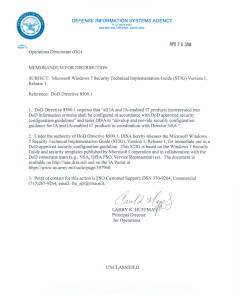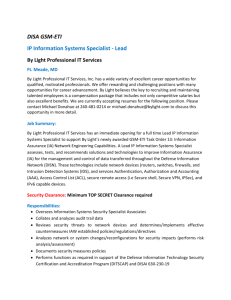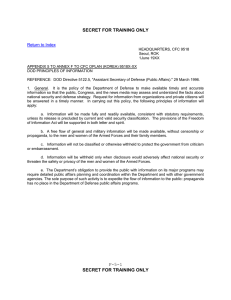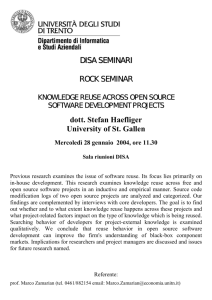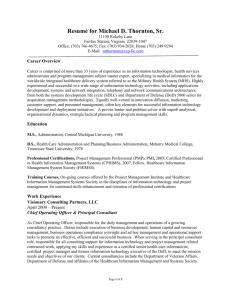DEPARTMENT OF DEFENSE DEFENSE-WIDE WORKING CAPITAL FUND INFORMATION SERVICES ACTIVITY GROUP
advertisement
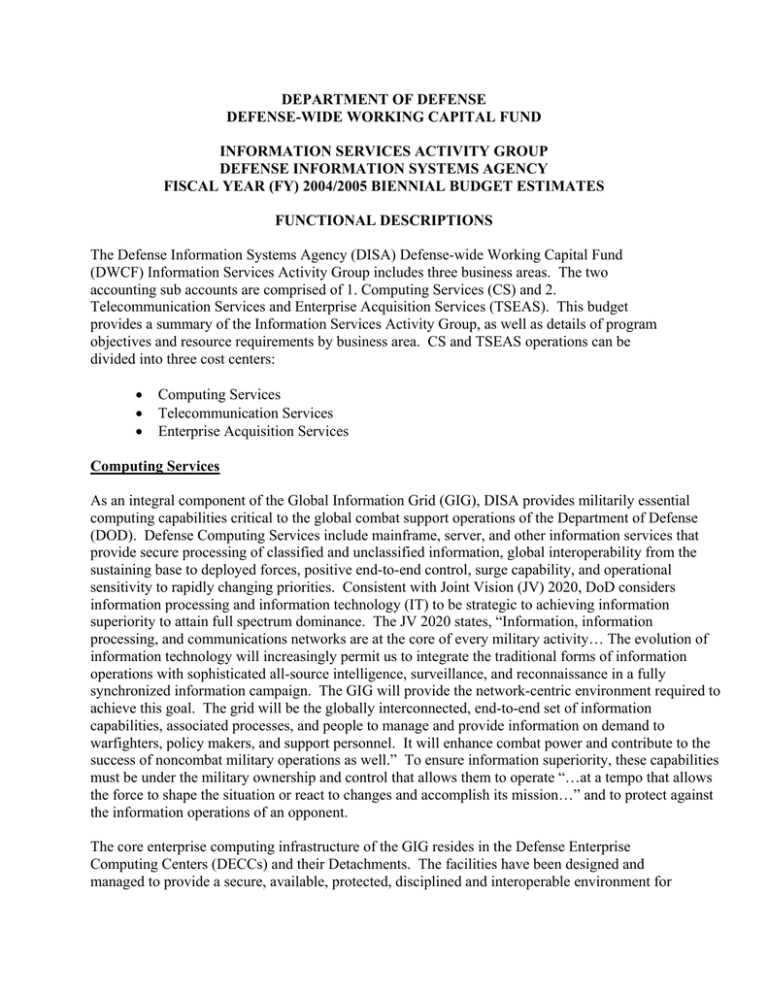
DEPARTMENT OF DEFENSE DEFENSE-WIDE WORKING CAPITAL FUND INFORMATION SERVICES ACTIVITY GROUP DEFENSE INFORMATION SYSTEMS AGENCY FISCAL YEAR (FY) 2004/2005 BIENNIAL BUDGET ESTIMATES FUNCTIONAL DESCRIPTIONS The Defense Information Systems Agency (DISA) Defense-wide Working Capital Fund (DWCF) Information Services Activity Group includes three business areas. The two accounting sub accounts are comprised of 1. Computing Services (CS) and 2. Telecommunication Services and Enterprise Acquisition Services (TSEAS). This budget provides a summary of the Information Services Activity Group, as well as details of program objectives and resource requirements by business area. CS and TSEAS operations can be divided into three cost centers: • • • Computing Services Telecommunication Services Enterprise Acquisition Services Computing Services As an integral component of the Global Information Grid (GIG), DISA provides militarily essential computing capabilities critical to the global combat support operations of the Department of Defense (DOD). Defense Computing Services include mainframe, server, and other information services that provide secure processing of classified and unclassified information, global interoperability from the sustaining base to deployed forces, positive end-to-end control, surge capability, and operational sensitivity to rapidly changing priorities. Consistent with Joint Vision (JV) 2020, DoD considers information processing and information technology (IT) to be strategic to achieving information superiority to attain full spectrum dominance. The JV 2020 states, “Information, information processing, and communications networks are at the core of every military activity… The evolution of information technology will increasingly permit us to integrate the traditional forms of information operations with sophisticated all-source intelligence, surveillance, and reconnaissance in a fully synchronized information campaign. The GIG will provide the network-centric environment required to achieve this goal. The grid will be the globally interconnected, end-to-end set of information capabilities, associated processes, and people to manage and provide information on demand to warfighters, policy makers, and support personnel. It will enhance combat power and contribute to the success of noncombat military operations as well.” To ensure information superiority, these capabilities must be under the military ownership and control that allows them to operate “…at a tempo that allows the force to shape the situation or react to changes and accomplish its mission…” and to protect against the information operations of an opponent. The core enterprise computing infrastructure of the GIG resides in the Defense Enterprise Computing Centers (DECCs) and their Detachments. The facilities have been designed and managed to provide a secure, available, protected, disciplined and interoperable environment for both classified and unclassified processing under military control. The infrastructure incorporates dual, high capacity DISN connectivity and organic defense in depth, resulting in a more secure and robust computing environment upon which to build. As an integral component of the GIG, DISA’s combat support computing provides global reachback, end-to-end control, defensive information operations, and operational sensitivity. The Defense computing infrastructure processes command and control and combat support requirements for warfighters deployed around the world. These requirements include command and control, transportation, finance, personnel, munitions, spare parts, medical supplies, and maintenance resources – all critical to military operations. Some of the critical requirements supported by the thousands of applications running in DISA facilities include the following: • Providing command and control of warfighting forces • Ensuring weapon systems availability through management and control of maintenance and supply • Managing and facilitating mobility of the warfighter through management and maintenance of the airlifter and tanker fleets • Providing warfighter sustainment through resupply and reorder • Providing the warfighter with information on the location, movement, status and identity of units, personnel, equipment, and supplies • Managing the medical environment and patient care • Supporting DoD business and eBusiness processes. Defense Enterprise Computing Centers include Columbus, OH, Mechanicsburg, PA, Ogden, UT, Oklahoma City, OK, St. Louis, MO, and OCONUS sites in Hawaii and Europe. Detachments include Chambersburg, PA, Dayton, OH, Denver, CO, Huntsville, AL, Jacksonville, FL, Montgomery, AL, Rock Island, IL, San Antonio, TX, San Diego, CA, Warner Robins GA, Puget Sound, WA, Norfolk, VA, Indianapolis, IN, and one OCONUS Information Technology Center (ITC) ITC Far East. The Computing Services budget includes four major transformation initiatives: consolidation of mainframe processing, selective consolidation of server processing, consolidation of systems management functions into systems management centers, and management restructuring. Implementation of these initiatives will be an evolving/dynamic process, adapting to the changing environment, and giving top priority to the needs of the warfighter, being self-financed through both current operating funds and the accumulated operating result. DISA will centralize headquarters functions such as business and resource management, acquisition, systems engineering, program management, and human resources. By streamlining the Computing Services enterprise, expected rate reductions will occur as evident in the FY 2004 and FY 2005 rates. Beginning in FY 2005, the transformed Computing Services will operate five lines of business: OS/390, Unisys, Server, Classified Processing, and Combatant Command Support. Each will be managed on a break-even basis, thereby eliminating cross-subsidization and facilitating operational efficiencies of the processing environments. The newly identified classified processing line of business will be restricted to systems operating in a Sensitive Compartmented Information Facility (SCIF). DISA’s Transformation effort is, in effect, proactive “right-sizing” of the entire Computing Services enterprise. As such, actions will be taken during Transformation that move workload, realign functions, and significantly impact staffing across the enterprise and on a site-by-site basis, and short-term operating results on a site-by-site basis. Individual detachments will no longer have responsibility for or control over all elements of cost and revenue. Therefore, rightsizing at the detachment level to maintain self-sustainability will no longer be possible. When losses are incurred, they will be corrected at the Enterprise level rather than through the currently practiced detachment right-sizing process. With the establishment of standardized pricing in FY 2006, DISA will manage the break-even position of each line of business through adjustment of Budget Year prices, taking any necessary management action to achieve operating efficiencies on an ongoing basis. The following highlights the impact of Transformation effort on individual activities and operations and the associated costs. Consolidation of mainframe processing. DISA currently operates five mainframe processing sites (Columbus, OH; Mechanicsburg, PA; Ogden, UT; Oklahoma City, OK; and St. Louis, MO). All five support OS/390 processing and two support Unisys processing, with San Antonio designated as a legacy site for Unisys. Mainframe workload will be consolidated into three OS/390 and two Unisys sites in conjunction with implementation of data mirroring and replication. The target sites will be carefully selected using fair, quantifiable, objective criteria consistent with previous usage. Mainframe consolidation is estimated to require $ 19.7 million for capital in FY 2003. Additionally, there are estimated one-time implementation costs of $6.0 million in FY 2003, and $ 17.6 million in FY 2004. As part of mainframe consolidation, DISA will establish an assured computing capability for the OS/390 operating environment, similar to that currently found in the UNISYS operating environment. There are five pillars of assured computing: facilities availability, equipment availability, communications availability, software availability, and data availability. Availability of the data is the most important pillar. DISA will implement data replication for the OS/390 mainframe environment in conjunction with the mainframe consolidations described previously. DISA is currently working with the vendor community to determine the best-value replication solution for the OS/390 environment. Assured computing will use a capacity-ondemand acquisition strategy for data replication beginning in FY 2003. The annual recurring cost for assured computing is estimated at $27.0 million, of which $15.0 million is for data replication. The remaining $12.0 million is required for facility upgrades and communication availability, which will support all processing environments. This initiative is predicated on the connection of each processing site to the GIG bandwidth expansion, an on-going DISA telecommunications infrastructure improvement initiative. Consolidation of server processing. DISA is evaluating alternatives to selectively consolidate some server processing into fewer sites. Initially, we will consolidate DFAS servers in FY 2003 and 2004, an action requested by the Director of DFAS. Server consolidation is estimated to require $4.0million for capital in FY 2003. Additionally, there is a small amount of one-time implementation costs, which will be expended in FY 2003. Consolidation of systems management. DISA will consolidate all systems management functions for mainframe and server computing into a minimal set of locations by the end of FY 2005, with primary and backup support for each operating environment. This will enable a significant reduction in staffing at most sites, as the applications run at sites that do not perform systems management functions will be managed remotely. Management Restructuring. The organization and staffing of DISA Computing Services’ headquarters and overhead functions will be restructured to reflect the impact of the physical and logical consolidation of operations functions. The current DECC and Detachment structure will be eliminated. Business management, resource management, engineering, acquisitions, logistics, workforce management, administration, and other overhead functions will be integrated and consolidated into a single virtual management organization located primarily at existing headquarters locations. During the same period, DISA CSD will discontinue supporting workloads that are non-core to its combat support-processing mission. Management restructuring and other/legacy/non-core changes are expected to impact every Computing Services activity. Telecommunication Services and Enterprise Acquisition Services The primary mission of TSEAS is to purchase telecommunications and related information technology products from the worldwide commercial sector to meet the needs of DoD Components and authorized non-defense customers. TSEAS enables DISA to build and sustain a critical component of the Global Information Grid (GIG), which provides the warfighter access to valid, secure, and operationally relevant information in a timely manner to ensure success of military operations. TSEAS operations can be divided into three functional components: • • • Defense Information Systems Network (DISN) Services Reimbursable Telecommunication Services Enterprise Acquisition Services Telecommunications Services provide a single source for high quality, reliable, survivable, and secure telecommunications services for defense command and control. TS is also an ideal source for procurement of best-value and commercially competitive information technology, as well as voice, data, and video services. The lowest possible customer price is attained through bulk quantity purchases, economies of scale, and reengineering current communication services. DISN Rate Based Services DISA’s core program is the Defense Information Systems Network (DISN). The DISN strategy is to consolidate the Military Departments’ and Defense Agencies’ telecommunications networks into one common-user network with interoperable equipment. DISN is a subset of the Defense Information Infrastructure (DII). DISN services are grouped into five lines of business: 1. 2. 3. 4. 5. 6. Voice Services Data Services Video Services Transmission Services Tier One Reimbursable Services Each of the six lines of business consists of unique DISA telecommunications service offerings programs that share a common objective. The programs within each service offering are listed in Table 1: Table 1: Components of the Defense Information Systems Network Rate Based Offering Voice Services Data Services Video Services Transmission Services Tier One Reimbursables Reimbursable Services Supporting Programs/Networks • • • • Defense Switched Network (DSN) Hawaii Information Transfer System (HITS) Internet Protocol Routers (IPR) Defense Video Teleconferencing Network (VTC) • Dedicated Transmission Network (MUX) • Caribbean Transmission Network (TRANS-B) • Pacific Transmission Network (TRANS-P) • European Transmission Network (TRANS-E) • Continental US Transmission Network (TRANS-C) • Southwest Asia Transmission Network (TRANS-S) • Asynchronous Transfer Mode (ATM) • Tier One Supporting Programs/Networks • • • • • • • Defense Red Switch Network (DRSN) Enhanced Mobile Satellite Services (EMSS) Joint Worldwide Intelligence Communications System (JWICS) Commercial Satellite Service Office (CSSO) Gigabit Switched Routers (GSR) Defense Messaging System (DMS) FTS Satellite Services DISA provides long-haul connections between the CINC/Service/Agency bases and to deployed forces. DISN provides dynamic routing of voice, text, imagery (both still and full motion), and bandwidth services on a fee-for-service basis. DISA provides government and contract engineering, modeling, simulation and assessment, and system control resources to support the operational DISN networks including: IPR, DSN, DRSN, and the Commercial Satellite Service Office (CSSO). Reimbursable Telecommunications Contracts In addition to the DISN, the TS budget provides a wide variety of cost-reimbursable telecommunications contracts for the Department of Defense community and other approved organizations. These contracts are treated as a “pass-through” expense to the Fund and mainly support Europe, Alaska, and Pacific for local unsecured telephone service. Enterprise Acquisition Services Enterprise Acquisition Services encompasses a variety of support services to meet DOD information technology contract requirements. DEIS II, INFOSEC, and Computer Technology are some of the larger contract vehicles serviced for enterprise integration services and security related procurements. The mission of Enterprise Acquisition Services also includes acquisition planning, procurement, and contract administration; accounting and vendor payment; customer billing and tariff issues. The most significant DOD customer is DISA, including Computing Services. MAJOR CHANGES BETWEEN FISCAL YEARS Computing Services FY 2003 President’s Budget Submission to FY 2003 Current Estimate FY 2003 Computing Services operating costs are $606.5 million, or $14.3 million less than the FY 2003 President’s Budget submission. The reduction is mostly due to the deletion of direct funding and cost to fund the full accrual of cost associated with the Civil Service Retirement System (CSRS) and Federal Employee Health Benefits (FEHB) program. The budget also includes several program level changes since the President’s Budget submission due to DISA’s initiatives as part of DOD’s Transformation process. Those initiatives are highlighted in DISA’s Transformation Roadmap. Cost estimates and associated savings included in this budget submission are based upon initiation of transformation actions beginning in January 2003. Delay or disapproval of the transformation plan will require restoration of end-strength and FTEs, additional labor and nonlabor costs, and revision to the stabilized rates included in this submission. Additionally, during FY 2003, Computing Services will establish a processing site in the European theater. Current plans estimate staffing of 3 government personnel with an initial operating budget of $3.0 million. DISA’s current capital estimate of $139.0 million is an increase of $84.0 million from the original FY 2003 estimate. This increase includes $20.8 million forwarded from FY 2002 for such programs as Medical Health Affairs, Air Force Integrated Maintenance Data System, facility support, and software for server processing. Additionally, the current estimate includes $60.0 million of new requirements for Transformation, Assured Computing and new customer server requirements. FY 2003 Current Estimate to FY 2004 Estimate Computing Services workload for both mainframe processing and non rate-based services continue to change reflecting a continuing increase in customer demand for information technology services. This budget submission assumes FY 2004 OS/390 CPU hours to increase by 1.8 percent or 64,000 hours while Unisys SUPS decrease by 32 percent or 1,061,000 SUPS, from the FY 2003 levels. At the same time, OS/390 mainframe rates decrease by 16 percent from FY 2003 and the Unisys SUPS rates remain largely static. Since FY 2000, there has been a consistent shift in the Computing Services workload and cost structure. Specifically, Computing Services has seen cost and revenue shift from mainframe processing to the server environment. To illustrate this transition, the cost of server processing from FY 2000 to FY 2004 has increased from $78.0 million to $178.0 million, whereas mainframe processing has decreased from $331.0 million in FY 2000 to $237.0 million in FY 2004. Along with this significant reduction in mainframe processing costs, mainframe workload has increased by 15.0 percent or 476,000 CPU hours over the same period. DISA continues to work towards implementation of a rate structure for server processing in FY 2006 . Telecommunication Services and Enterprise Acquisition Services FY 2003 President’s Budget Submission to FY 2003 Current Estimate The TSEAS budget contains FY 2003 costs of $2,497.9 million, or $184.9 million more than the FY 2003 President’s Budget Submission. This increase is mainly due to increases for Internet connectivity and backbone capacity, as well as the mandatory utilization of the NIPRNet by the DoD community. Likewise, SIPRNet connections are expected to increase at a pace of about 15.0 percent over the next few years. This coupled with revised customer requirements for NMCI, using Gigabit Switched Router (GSR) service, will increase overall network operations and transmission costs. Budgeted cost for Internet Protocol Router (IPR) and GSR services are $158.5 million greater than FY 2003 President’s Budget Submission levels. Transmission costs are $36.9 million higher. As a result of actual FY 2002 experience and sustainable workload trends Commercial Satellite Services (CSSO) and Joint World Wide Intelligence Communication Services (JWICS) are also budgeted for significant operational growth in FY 2003. In addition, DISA is now budgeting for on-going Contingency Operations in Bosnia and Kosovo totaling $38.2 million in FY 2003 and beyond. The execution budget may also reflect additional costs for the Global War On Terrorism (GWOT). DISA will seek funded customer orders for any workload increases in support of GWOT. In Contrast, the FY 2003 President’s Budget overstated requirements among Enterprise Acquisition Services contracts and FTS-2000 services; reimbursable IT contract cost estimates were also reduced by $74.1 million and $20.3 million, respectively, for these services. FY 2003 Current Estimate to FY 2004 Estimate In FY 2004, the impact of continued customer growth for NIPRNet, SIPRNet, and associated transmission services will result in a net increase of $79.7 million over FY 2003 levels. Cost increases are also evident in voice communications, principally the Defense Switches Network. The DISA DWCF no longer includes operating cost for Enhance Mobile Satellite Services (EMSS or Iridium), resulting in a $49.1 million reduction from FY 2003 levels. Beginning in FY 2004, EMSS is funded as a reimbursable operation through the DISA Operations and Maintenance account. OPERATING BUDGET Each DISA DWCF business area achieves a zero Accumulated Operating Results (AOR) by the end of FY 2004. The Computing Services operating budget includes the financial impact of a one-time investment for Transformation. Table 2 provides a summary of our estimate for FY 2003 operating results and estimates for FY 2004 and FY 2005: Table 2: Operating Budget Summary Computing Services Revenue Costs Net Operating Result (NOR) Accumulated Operating Result (AOR) FY 2003 590.2 606.5 -16.3 22.1 $ in Millions FY 2004 594.8 616.9 -22.1 0.0 FY 2005 592.2 592.2 0.0 0.0 Telecommunication Services and Enterprise Acquisition Services FY 2003 $ in Millions FY 2004 FY 2005 Revenue 2,556.4 2,564.8 2,653.2 Costs Net Operating Result (NOR) Accumulated Operating Result (AOR) 2,497.9 58.4 12.8 2,577.6 -12.8 0.0 2,653.2 0.0 0.0 CAPITAL INVESTMENT BUDGET Capital investment program requirements are generally predicated on the replacement of major telecommunications and ADPE equipment when current equipment is no longer maintainable, or when replacement parts are not available. DISA strives to provide customers with quality service through the latest technology, and the capital program supports the insertion of new technology through major equipment purchases, which provides service enhancements and future cost reductions. The FY 2004 Computing Services capital budget program includes estimates for: facilities/infrastructure replacements; optimization and replacement of mainframe and server systems; software standard operating environment; integrated storage solutions for computing processing; communication devices; and transformation initiatives. The FY 2004 TSEAS capital budget reflects a greater management emphasis on this funding mechanism as a means of procuring information technology equipment and systems to DISA’s warfighting support mission. This includes a budget request totaling $116.6 million in FY 2003 which is $61.4 million greater than the FY 2003 President’s Budget level. Numerous projects have also been substituted, deleted, and added to achieve operational efficiency. Multiyear procurements are planned for CONUS Multi Function Switches, HITS Multi Function Switches, Router Deployment, Internet Protocol Core Network Expansion, and other equipment requirements. In addition to DWCF capital investment initiatives, TSEAS customers are also expected to benefit from appropriated investment in the GIG-BE. This initiative fully supports the Department's network-centric warfare transformation objectives and achieves multiple benefits for GIG users. It corrects longstanding sub-optimization and shortages in the acquisition and slowed network response times. It leverages DOD's increasing investments in real-time surveillance capabilities. It underpins the ability of deployed forces "to plan and execute faster than the enemy and seize technical opportunities" by providing sufficient bandwidth for unanticipated requirements. It provides for network survivability by eliminating single point of failure. Table 3 summarizes the capital program. Table 3: Capital Budget Summary $ in Millions Computing Services TSEAS Total Capital Program FY 2003 139.3 116.6 255.9 FY 2004 72.7 87.2 159.9 FY 2005 64.0 64.6 128.6 CUSTOMER RATES, RATE DESIGN, AND UNIT COST Computing Services Computing Services rates reflect DISA’s Transformation initiative which will result in the consolidation of mainframe processing, server processing, systems management, and management restructuring. The Computing Services budget has two basic methods of cost recovery, rate based and direct reimbursement. Each methodology is designed to capture the total cost of operations, including direct and overhead costs. This table provides the proposed computing customer rates: Table 4: Computing Services Customer Rates Work Load Units FY 2003 Unisys SUPS 13.8542 (Dollars per Unit) FY 2004 13.8535 FY 2005 13.8525 Work Load Units FY 2003 0.0252 0.0010 FY 2003 28.9265 0.0291 0.0073 0.2973 0.0007 0.0000 DASD MB Days Tape Storage (MB/Days) OS/390 CPU Hours (OS/390) I/O Transfers (OS/390) DASD MB Days (OS/390) Tape Mounts Cartridge (OS/390) Cartridge MB Days (OS/390) DASD Assured Computing (Dollars per Unit) FY 2004 0.0248 0.0013 FY 2004 24.1681 0.0270 0.0073 0.3010 0.0007 0.0000 FY 2005 0.0246 0.0012 FY 2005 22.9127 0.0269 0.0061 0.3595 0.0007 0.0029 Telecommunication Services Pricing Structure: The DISA pricing structure for Telecommunications Services is designed to incentivize customers and recognize their use as military value added capabilities within the context of providing utility-like services for common good and promote security, interoperability and efficient practices across DOD. This includes a two-tiered pricing approach to Telecommunications Services. Tier-One pricing recover the costs of the core infrastructure required to produce military readiness attributes of the DISN. For FY04 and FY05, Tier-One costs are centrally funded in the DISA Operations and Maintenance account. Tier-Two pricing recovers the cost of usage associated with the delivery of information services to the customer. Prices are developed for the DISN Services from an analysis of tier-two network cost drivers and customer service requirements by theater. This includes identifying unique system costs and dividing those total costs including depreciation and communications operations/network management proportionately by unit (e.g., ports, connections, data packets, minutes of use, precedence, capability, etc) to determine a price per unit. This price per unit, along with the assessment of an overhead fee, is charged for the services requested by the customer. Enterprise Acquisition Services Enterprise Acquisition Services is a fee-for-service charge of 2 percent on each contract cost. PERFORMANCE INDICATORS DISA drafted its FY 2004 Performance Plan to demonstrate alignment with the management goals of the President’s Management Agenda, the Quadrennial Defense Review’s performance goals for risk management (balanced scorecard approach), and the Government Performance and Results Act. These alignments will be further enhanced as we implement DoD Management Initiatives. The result will be an improved performance management system that emphasizes delivering advanced capabilities to the warfighter and better accountability for assigned missions. Computing Services The Computing Services budget includes performance measures, which support system availability and responsiveness, and value to the customer: 1. 2. 3. 4. Provide mainframe information processing services while incurring no more than specified unit costs. All peak workload requirements will be met while maintaining an average utilization of installed OS 390 capacity of at least 70 percent. Users will experience MVS and Unisys platform availability of at least 98 percent. Complete a survey of Computing/Information Processing Service customers annually. Identify major concerns and issues. Not later than October 31, following the completion of the fiscal year, report to the Defense Management Council (DMC) an action plan that addresses all major issue areas with customers. Rate-based OS/390 processing is 32% of the total DISA Computing Services DWCF budget. The FY 2004 Goal is $24.17/per CPU hour for OS/390 processing. Telecommunication Services and Enterprise Acquisition Services The TSEAS budget includes Performance Measures associated with the FY 2003 Performance Contract. This includes providing telecommunications services while incurring no more than the following unit costs. Table 5 summarizes these measures for Telecommunications. DSN is the voice subsystem of the aggregate of networks referred to as the DISN. The DSN provides rapid, reliable, survivable, non-secure/secure, and economical C2 telecommunications worldwide during all conditions of peace and war. The FY 2004 Goal is $ .108/minute for C2 Voices services (world-wide average). The fee for Enterprise Acquisition Services will be competitive with the fee charged for similar services by other DoD and Federal Government contracting organizations throughout FY 2004. Table 5: Performance Indicators Theater Average Annual Unit Cost (TY$) Voice ($/min) CONUS Caribbean PAC Europe SW Asia Data ($/kb) CONUS Caribbean PAC Europe SW Asia FY 2003 FY 2004 FY 2005 0.0286 0.0446 0.1059 0.1657 0.1726 0.0286 0.0446 0.1059 0.1465 0.1726 0.0255 0.3970 0.0942 0.1304 0.1536 10.0800 10.0800 22.4700 21.1800 26.5900 10.0800 10.0800 22.4700 21.1800 26.5900 8.8200 8.8200 19.6500 18.5300 23.2600 Theater Average Annual Unit Cost (TY$) Video ($/min) CONUS Caribbean PAC Europe SW Asia Transmission ($/kb) CONUS Caribbean PAC Europe SW Asia FY 2003 FY 2004 FY 2005 1.5170 1.5170 2.6100 2.4800 2.4800 1.5170 1.5170 2.6100 2.4800 2.4800 1.5170 1.5170 2.6100 2.4800 2.4800 21.7140 21.7140 21.7140 21.7140 21.7140 18.9210 18.9210 18.9210 18.9210 18.9210 16.2940 16.2940 16.2940 16.2940 16.2940 Performance measures are also based on providing support minimum DISN workload levels. Table 6 summarizes this workload. Table 6: Workload Estimates DoD Common User Telecommunications Workload Voice (G/minutes) Data (G/bytes) Video (M/minutes) Transmission (K/bytes) FY 2003 FY 2004 1.233 9.044 9.666 9.553 1.328 12.318 10.303 11.331 FY 2005 1.394 14.890 10.818 13.598 CIVILIAN PERSONNEL Computing Services From FY 2003 and continuing through FY 2005, through the implementation of transformation initiatives, DISA is estimating Computing Services staffing level reductions of approximately 716 or 30 percent. This includes mainframe staffing reductions of over 50 percent. Additional efficiencies and staffing reductions are expected in the mid-tier server and overhead areas. Computing Services operations will retain the flexibility to adjust staffing upward or downward to fully support funded customer requirements. Labor cost estimates shown below include Voluntary Separation Incentive Pay, Voluntary Early Retirement Pay, Terminal leave and Severance Pay totaling $0.9 million in FY 2003, $6.0 million in FY 2004, and $17.2 million in FY 2005. Telecommunication Services and Enterprise Acquisition Services The Telecommunication Services/Enterprise Acquisition Services civilian personnel budget remains largely static over the budget years. This trend notwithstanding, DISA continues to evaluate staffing requirements across the TSEAS business area. Table 7 provides an overview of civilian personnel levels and costs for the DISA agency. Table 7: Civilian Personnel Computing Services FY 2003 Civilian End Strength * Civilian FTE * Civilian Personnel Cost ($ Millions) FY 2004 2,403 2,421 $196.0 FY 2005 2,183 2,244 $202.0 1,687 1,822 $168.5 * Includes Foreign Nationals Telecommunication Services and Enterprise Acquisition Services Civilian End Strength Civilian FTE Civilian Personnel Cost ($ Millions) FY 2003 FY 2004 533 533 $39.4 FY 2005 533 533 $40.4 533 533 $41.6 MILITARY PERSONNEL The overall number of reimbursable Military Personnel (MILPERS) assigned to TSEAS and Computing Services remain relatively flat through the budget years. The small increase for TSEAS in FY 2004 reflects expanded mission requirements at CONUS RNOSC located at the DISN Service Center, Scott Air Force Base. Table 8 provides a synopsis of DISA DWCF MILPERS levels and costs. Table 8: Military Personnel Computing Services FY 2003 Military End Strength Military Workyears Military Personnel Cost ($ Millions) Telecommunication Services and Enterprise Acquisition Services Military End Strength Military Workyears Military Personnel Cost ($ Millions) FY 2004 14 14 $1.4 FY 2003 FY 2005 14 14 $1.3 FY 2004 32 32 $1.9 14 14 $1.4 FY 2005 35 35 $2.3 35 35 $2.3 Changes in the Costs of Operations Component: Defense Information Systems Agency Activity Group: CS January, 2003 (Dollars in Millions) FY 2002 Actual 548.395 FY 2003 Estimate in President's Budget Pricing Adjustments: Inflation 620.829 3.633 Program Changes: Personnel Compensation: FEHB/CSRS Personnel Compensation: Adjustments for Voluntary Separation Material, Equipment & Supplies Other Intrafund Purchases: Base Operating Cost/Printing Other Intrafund Purchases: Communications Cost Depreciation: Equipment for Transformation Advisory and Assistance Services: Contracts for Transformation Other Purchased Services: HW/SW / WKLD Reductions Mainframe Various Net Program Adjustments FY 2003 Current Estimate Pricing Adjustments: Inflation (13.229) (9.913) 1.231 6.942 (1.471) 3.112 5.767 (12.026) 1.590 606.465 11.562 Program Changes: Personnel Compensation: Transformation Reductions Personnel Compensation: Voluntary Separation/Benefits/Retirement Material, Equipment & Supplies: Local Non-Capital Equipment Depreciation: New WKLD for Server / Mainframe Refresh Advisory and Assistance Services: Contracts for Transformation Other Purchased Services: Equipment Maintenance Transformation Other Purchased Services: Other Contracts Transformation Various Net Program Adjustments (4.480) 4.593 (2.261) 32.482 (14.767) (9.920) (4.564) (2.212) FY 2004 Estimate Pricing Adjustments: Inflation 616.898 9.575 Program Changes: Personnel Compensation: Transformation Reductions Personnel Compensation: Voluntary Separation/Benefits/Retirement Material, Equipment & Supplies: Local Non Capital Equipment Other Intrafund Purchases: Communications Cost Other Intrafund Purchases: Base Operating Cost Depreciation: New WKLD for Server Advisory and Assistance Services: Contracts for Transformation Other Purchased Services: Other Contracts Transformation Other Purchased Services: Equipment Maintenance Transformation Various Net Program Adjustments FY 2005 Estimate (46.528) 8.608 (1.404) 7.511 (2.619) 26.706 (19.046) (9.562) 2.745 (0.720) 592.164 Page 1 of 1 Exhibit Fund-2, Changes in the Costs of Operations Changes in the Costs of Operations Component: Defense Information Systems Agency Activity Group: TSEAS January, 2003 (Dollars in Millions) FY 2002 Actual 2,246.393 FY 2003 Estimate in President's Budget Pricing Adjustments: Inflation 2,312.957 (12.100) Program Changes: Data Services (eg NIPRNET, SIPRNET) workload growth Commercial Satellite Systems Office workload growth Contingency Operations (Kosovo, Bosnia) Transmission Services workload growth Joint Worldwide Intelligence Communicaitons System Workload Gigabit Switched Router Service workload growth Enterprise Acquisition Services Contracts FTS 2000 workload adjustment Other Changes: FEHB/CSRS & pay adjustment (2.206) FY 2003 Current Estimate Pricing Adjustments: Inflation 2,497.861 34.994 Program Changes: Transmisison Service workload growth Gigabit Switched Router Service workload growth Voice Services workload growth Enhanced Mobile Satellite Services - transfered to O&M account Data Services workload adjustment Various net program adjustments Other Changes: FEHB/CSRS & pay adjustment FY 2004 Estimate Pricing Adjustments: Inflation Program Changes: Various net program adjustments Other Changes: FY 2005 Estimate Page 1 of 1 94.061 64.442 38.235 36.900 32.699 27.238 (74.070) (20.295) 58.000 48.690 20.078 (49.133) (22.760) (7.426) (2.700) 2,577.604 35.714 11.850 2,625.168 Exhibit Fund-2, Changes in the Costs of Operations Source of New Orders and Revenue Component: Defense Information Systems Agency Activity Group: TSEAS and CS January, 2003 (Dollars in Millions) 1. New Orders a. Orders from DoD Components Air Force Appropriated Army Appropriated Navy and Marine Corps Appropriated DISA Appropriated Other DoD b. Orders from Other Fund Activity Groups Air Force - Working Capital Army - Working Capital Navy - Working Capital DISA - Working Capital DFAS DLA Defensewide - Working Capital Computing Services c. Total DoD d. Other Orders FAA Other Federal Agencies Other Non-Federal Total New Orders FY 2002 FY 2003 FY 2004 FY 2005 492.665 323.086 246.351 487.501 593.264 462.113 332.874 427.545 489.733 396.090 473.883 341.754 478.575 445.700 386.091 470.571 346.706 476.493 480.425 392.900 66.895 9.978 51.828 6.262 157.604 85.547 12.297 0.000 65.326 13.739 53.200 6.104 155.673 83.803 10.457 312.129 69.083 13.732 47.577 6.618 161.101 75.788 10.553 317.296 64.722 12.079 49.419 7.241 168.153 78.013 11.405 322.465 2,533.278 2,808.786 2,827.751 2,880.592 222.920 70.682 0.626 229.313 107.342 1.134 215.809 115.719 0.293 214.497 121.942 0.301 2,827.506 3,146.575 3,159.572 3,217.332 0.000 0.000 0.000 0.000 2,827.506 3,146.575 3,159.572 3,217.332 0.303 0.000 0.000 0.000 2,827.809 3,146.575 3,159.572 3,217.332 2. Carry In Orders 3. Total Gross Orders 4. Other Income 5. Revenue 6. End of Year Work in Process 0.000 0.000 0.000 0.000 7. Direct Contract Obligations 0.000 0.000 0.000 0.000 8. Non-DoD, BRAC, FMS, and DWCF Orders 0.000 0.000 0.000 0.000 9. Funded Carry-Over (Charge to Backlog) 0.000 0.000 0.000 0.000 0.000 0.000 0.000 0.000 10. Months of Carry-Over Page 1 of 1 Exhibit Fund-11, Source of New Orders and Revenue Source of New Orders and Revenue Component: Defense Information Systems Agency Activity Group: CS January, 2003 (Dollars in Millions) 1. FY 2002 FY 2003 FY 2004 FY 2005 87.159 37.372 39.739 17.279 21.841 86.595 34.616 36.910 21.641 44.578 93.975 36.397 34.428 23.463 44.991 85.795 29.637 34.083 25.672 48.623 Orders from Other Fund Activity Groups Air Force - Working Capital Army - Working Capital Navy - Working Capital DISA - Working Capital DFAS DLA Defensewide - Working Capital 66.895 9.978 51.828 6.262 150.364 62.095 12.297 65.326 11.539 53.200 6.104 148.556 65.655 10.457 69.083 11.532 47.577 6.618 153.504 56.617 10.553 64.722 9.879 49.419 7.241 159.978 58.533 11.405 c. Total DoD 563.109 585.177 588.738 584.987 d. Other Orders Other Federal Agencies 2.997 5.023 6.015 7.177 566.106 590.200 594.753 592.164 0.000 0.000 0.000 0.000 566.106 590.200 594.753 592.164 0.303 0.000 0.000 0.000 566.409 590.200 594.753 592.164 New Orders a. Orders from DoD Components Air Force Appropriated Army Appropriated Navy and Marine Corps Appropriated DISA Appropriated Other DoD b. Total New Orders 2. Carry In Orders 3. Total Gross Orders 4. Other Income 5. Revenue 6. End of Year Work in Process 0.000 0.000 0.000 0.000 7. Direct Contract Obligations 0.000 0.000 0.000 0.000 8. Non-DoD, BRAC, FMS, and DWCF Orders 0.000 0.000 0.000 0.000 9. Funded Carry-Over (Charge to Backlog) 0.000 0.000 0.000 0.000 0.000 0.000 0.000 0.000 10. Months of Carry-Over Page 1 of 1 Exhibit Fund-11, Source of New Orders and Revenue Source of New Orders and Revenue Component: Defense Information Systems Agency Activity Group: TSEAS January, 2003 (Dollars in Millions) 1. New Orders a. Orders from DoD Components Air Force Appropriated Army Appropriated Navy and Marine Corps Appropriated DISA Appropriated Other DoD b. Orders from Other Fund Activity Groups Army - Working Capital DFAS DLA Computing Services c. Total DoD d. Other Orders FAA Other Federal Agencies Other Non-Federal Total New Orders FY 2002 FY 2003 FY 2004 FY 2005 405.506 285.714 206.612 470.222 571.423 375.518 298.258 390.635 468.092 351.512 379.908 305.357 444.147 422.237 341.100 384.776 317.069 442.410 454.753 344.277 0.000 7.240 23.452 0.000 2.200 7.117 18.148 312.129 2.200 7.597 19.171 317.296 2.200 8.175 19.480 322.465 1,970.169 2,223.609 2,239.013 2,295.605 222.920 67.685 0.626 229.313 102.319 1.134 215.809 109.704 0.293 214.497 114.765 0.301 2,261.400 2,556.375 2,564.819 2,625.168 0.000 0.000 0.000 0.000 2,261.400 2,556.375 2,564.819 2,625.168 0.000 0.000 0.000 0.000 2,261.400 2,556.375 2,564.819 2,625.168 2. Carry In Orders 3. Total Gross Orders 4. Other Income 5. Revenue 6. End of Year Work in Process 0.000 0.000 0.000 0.000 7. Direct Contract Obligations 0.000 0.000 0.000 0.000 8. Non-DoD, BRAC, FMS, and DWCF Orders 0.000 0.000 0.000 0.000 9. Funded Carry-Over (Charge to Backlog) 0.000 0.000 0.000 0.000 0.000 0.000 0.000 0.000 10. Months of Carry-Over Page 1 of 1 Exhibit Fund-11, Source of New Orders and Revenue Revenue and Expenses Component: Defense Information Systems Agency Activity Group: TSEAS and CS January, 2003 (Dollars in Millions) Revenue Gross Sales Operations Capital Surcharge Depreciation Excluding Major Construction Major Construction Depreciation Other Income Refunds/Discounts(-) Total Income Expenses Salaries and Wages: Military Personnel Compensation & Benefits Civilian Personnel Compensation & Benefits Travel & Transportation of Personnel Materials and Supplies Equipment Other Purchases from Revolving Funds Transportation of Things Depreciation Capital Rent, Communications, Utilities, & Misc. Charges Printing and Reproduction Advisory and Assistance Services Other Purchased Services Total Expenses Operating Result Less Capital Surcharge Reservation Plus Passthroughs and Other Appropriations Affecting NOR Other Adjustments Affecting NOR Net Operating Result Prior Year AOR Other Changes Affecting AOR Accumulated Operating Result Non Recoverable Adjustment Impacting AOR Accumulated Operating Result for Budget Purpose Page 1 of 1 FY 2002 FY 2003 FY 2004 FY 2005 2,768.211 0.000 59.295 0.000 0.303 3,090.187 0.000 56.388 0.000 0.000 3,042.409 0.000 117.163 0.000 0.000 3,060.357 0.000 156.975 0.000 0.000 2,827.809 3,146.575 3,159.572 3,217.332 3.174 228.287 5.389 159.493 0.000 30.060 0.123 59.295 1,528.134 0.364 84.760 695.709 2,794.788 3.306 235.865 10.018 112.992 0.000 38.384 0.071 56.388 1,388.899 0.823 122.729 1,134.851 3,104.326 3.587 242.981 8.989 113.233 0.000 38.301 0.072 117.163 1,360.139 0.819 109.807 1,199.411 3,194.502 3.678 210.580 8.999 120.786 0.000 44.085 0.277 156.975 1,368.190 0.815 92.412 1,210.535 3,217.332 33.021 42.249 (34.930) 0.000 0.000 0.000 0.000 0.000 0.000 0.000 0.000 0.000 0.000 0.000 0.000 0.000 33.021 42.249 (34.930) 0.000 89.622 (129.962) (7.319) 0.000 34.930 0.000 (0.000) 0.000 (7.319) 0.000 (7.319) 34.930 0.000 34.930 (0.000) 0.000 (0.000) (0.000) 0.000 (0.000) Exhibit Fund-14, Revenue and Expenses Revenue and Expenses Component: Defense Information Systems Agency Activity Group: CS January, 2003 (Dollars in Millions) FY 2002 Revenue Gross Sales Operations Capital Surcharge Depreciation Excluding Major Construction Major Construction Depreciation Other Income Refunds/Discounts(-) Total Income Expenses Salaries and Wages: Military Personnel Compensation & Benefits Civilian Personnel Compensation & Benefits Travel & Transportation of Personnel Materials and Supplies Equipment Other Purchases from Revolving Funds Transportation of Things Depreciation Capital Rent, Communications, Utilities, & Misc. Charges Printing and Reproduction Advisory and Assistance Services Other Purchased Services Total Expenses Operating Result Less Capital Surcharge Reservation Plus Passthroughs and Other Appropriations Affecting NOR Other Adjustments Affecting NOR Net Operating Result Prior Year AOR Other Changes Affecting AOR Accumulated Operating Result Non Recoverable Adjustment Impacting AOR Accumulated Operating Result for Budget Purpose Page 1 of 1 FY 2003 FY 2004 FY 2005 526.313 0.000 39.793 0.000 0.303 553.288 0.000 36.912 0.000 0.000 525.359 0.000 69.394 0.000 0.000 496.064 0.000 96.100 0.000 0.000 566.409 590.200 594.753 592.164 1.662 192.099 3.779 18.656 0.000 30.060 0.109 39.793 5.241 0.302 84.760 171.934 548.395 1.408 195.974 6.567 19.375 0.000 31.417 0.017 36.912 6.231 0.730 120.679 187.155 606.465 1.330 202.047 5.767 17.405 0.000 31.193 0.017 69.394 6.127 0.724 107.722 175.172 616.898 1.364 168.509 5.558 16.263 0.000 36.480 0.017 96.100 5.816 0.718 90.292 171.047 592.164 18.014 (16.265) (22.145) 0.000 0.000 0.000 0.000 0.000 0.000 0.000 0.000 0.000 0.000 0.000 0.000 0.000 18.014 (16.265) (22.145) 0.000 164.161 (143.765) 38.410 0.000 22.145 0.000 0.000 0.000 38.410 0.000 38.410 22.145 0.000 22.145 0.000 0.000 0.000 0.000 0.000 0.000 Exhibit Fund-14, Revenue and Expenses Revenue and Expenses Component: Defense Information Systems Agency Activity Group: TSEAS January, 2003 (Dollars in Millions) Revenue Gross Sales Operations Capital Surcharge Depreciation Excluding Major Construction Major Construction Depreciation Other Income Refunds/Discounts(-) Total Income Expenses Salaries and Wages: Military Personnel Compensation & Benefits Civilian Personnel Compensation & Benefits Travel & Transportation of Personnel Materials and Supplies Equipment Other Purchases from Revolving Funds Transportation of Things Depreciation Capital Rent, Communications, Utilities, & Misc. Charges Printing and Reproduction Advisory and Assistance Services Other Purchased Services Total Expenses Operating Result Less Capital Surcharge Reservation Plus Passthroughs and Other Appropriations Affecting NOR Other Adjustments Affecting NOR Net Operating Result Prior Year AOR Other Changes Affecting AOR Accumulated Operating Result Non Recoverable Adjustment Impacting AOR Accumulated Operating Result for Budget Purpose Page 1 of 1 FY 2002 FY 2003 FY 2004 FY 2005 2,241.898 0.000 19.502 0.000 0.000 2,536.899 0.000 19.476 0.000 0.000 2,517.050 0.000 47.769 0.000 0.000 2,564.293 0.000 60.875 0.000 0.000 2,261.400 2,556.375 2,564.819 2,625.168 1.512 36.188 1.610 140.837 0.000 0.000 0.014 19.502 1,522.893 0.062 0.000 523.775 2,246.393 1.898 39.891 3.451 93.617 0.000 6.967 0.054 19.476 1,382.668 0.093 2.050 947.696 2,497.861 2.257 40.934 3.222 95.828 0.000 7.108 0.055 47.769 1,354.012 0.095 2.085 1,024.239 2,577.604 2.314 42.071 3.441 104.523 0.000 7.605 0.260 60.875 1,362.374 0.097 2.120 1,039.488 2,625.168 15.007 58.514 (12.785) 0.000 0.000 0.000 0.000 0.000 0.000 0.000 0.000 0.000 0.000 0.000 0.000 0.000 15.007 58.514 (12.785) 0.000 (74.539) 13.803 (45.729) 0.000 12.785 0.000 (0.000) 0.000 (45.729) 0.000 (45.729) 12.785 0.000 12.785 (0.000) 0.000 (0.000) (0.000) 0.000 (0.000) Exhibit Fund-14, Revenue and Expenses
